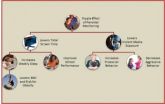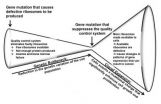(Press-News.org) (Lebanon, NH, 3/31/14) — Fast food giants attempts at depicting healthier kids' meals frequently goes unnoticed by children ages 3 to 7 years old according to a new study by Dartmouth-Hitchcock Norris Cotton Cancer Center. In research published on March 31, 2014 in JAMA Pediatrics, Dartmouth researchers found that one-half to one-third of children did not identify milk when shown McDonald's and Burger King children's advertising images depicting that product. Sliced apples in Burger King's ads were identified as apples by only 10 percent of young viewers; instead most reported they were french fries.
Other children admitted being confused by the depiction, as with one child who pointed to the product and said, "And I see some…are those apples slices?"
The researcher replied, "I can't tell you…you just have to say what you think they are."
"I think they're french fries," the child responded.
To view a videotape of this and other responses from children participating in the study, click on the following link: http://youtu.be/Tl9uHUeWztY
"Burger King's depiction of apple slices as 'Fresh Apple Fries' was misleading to children in the target age range," said principal investigator James Sargent, MD, co-director Cancer Control Research Program at Norris Cotton Cancer Center. "The advertisement would be deceptive by industry standards, yet their self-regulation bodies took no action to address the misleading depiction."
In 2010 McDonald's and Burger King began to advertise apples and milk in kids meals. Sargent and his colleagues studied fast food television ads aimed at children from July 2010 through June 2011. In this study researchers extracted "freeze frames" of Kids Meals shown in TV ads that appeared on Cartoon Network, Nickelodeon, and other children's cable networks. Of the four healthy food depictions studied, only McDonald's presentation of apple slices was recognized as an apple product by a large majority of the target audience, regardless of age. Researchers found that the other three presentations represented poor communication.
This study follows an earlier investigation conducted by Sargent and his colleagues, which found that McDonald's and Burger King children's advertising emphasized giveaways like toys or box office movie tie-ins to develop children's brand awareness for fast food chains, despite self-imposed guidelines that discourage the practice.
While the Food and Drug Administration and the Federal Trade Commission play important regulatory roles in food labeling and marketing, the Better Business Bureau operates a self-regulatory system for children's advertising. Two different programs offer guidelines to keep children's advertising focused on the food, not toys, and, more specifically, on foods with nutritional value.
"The fast food industry spends somewhere between $100 to 200 million dollars a year on advertising to children, ads that aim to develop brand awareness and preferences in children who can't even read or write, much less think critically about what is being presented." said Sargent.
INFORMATION:
This study was funded by the Robert Wood Johnson Foundation's Healthy Eating Research program.
About Norris Cotton Cancer Center at Dartmouth-Hitchcock
Norris Cotton Cancer Center combines advanced cancer research at the Geisel School of Medicine at Dartmouth with patient-centered cancer care provided at Dartmouth-Hitchcock Medical Center, at Dartmouth-Hitchcock regional locations in Manchester, Nashua, and Keene, NH, and St. Johnsbury, VT, and at 12 partner hospitals throughout New Hampshire and Vermont. It is one of 41 centers nationwide to earn the National Cancer Institute's "Comprehensive Cancer Center" designation. Learn more about Norris Cotton Cancer Center research, programs, and clinical trials online at cancer.dartmouth.edu.
Fast food giants' ads for healthier kids meals don't send the right message
Apple slices perceived as french fries and milk not identified by large percentage of children
2014-03-31
ELSE PRESS RELEASES FROM THIS DATE:
EARTH Magazine: The trouble with turtles
2014-03-31
Alexandria, Va. – Turtles are the last major living vertebrate group to be placed firmly on the tree of life, and the arguments are getting messy. Three fields in particular — paleontology, developmental biology and microbiology/genomics — disagree about how, and from what, turtles may have evolved. In the latest EARTH Magazine feature story, contributing writer Naomi Lubick investigates how these creatures confound scientists on many levels — from their morphology in the paleontological record and in modern day turtles, to the analysis of their genome. Where do they belong ...
Limiting screen time yields mulitple benefits, ISU study finds
2014-03-31
AMES, Iowa – Parents may not always see it, but efforts to limit their children's screen time can make a difference. A new study, published in JAMA Pediatrics, found children get more sleep, do better in school, behave better and see other health benefits when parents limit content and the amount of time their children spend on the computer or in front of the TV.
Douglas Gentile, lead author and an associate professor of psychology at Iowa State, says the effect is not immediate and that makes it difficult for parents to recognize. As a result, parents may think it ...
Early cardiac risks linked to worse cognitive function in middle age
2014-03-31
Young adults with such cardiac risk factors as high blood pressure and elevated glucose levels have significantly worse cognitive function in middle age, according to a new study by dementia researchers at UC San Francisco.
The findings bolster the view that diseases like Alzheimer's develop over an individual's lifespan and may be set in motion early in life. And they offer hope that young adults may be able to lower their risk of developing dementia through diet and exercise, or even by taking medications.
"These cardiovascular risk factors are all quite modifiable," ...
Computer maps 21 distinct emotional expressions -- even 'happily disgusted'
2014-03-31
COLUMBUS, Ohio—Researchers at The Ohio State University have found a way for computers to recognize 21 distinct facial expressions—even expressions for complex or seemingly contradictory emotions such as "happily disgusted" or "sadly angry."
In the current issue of the Proceedings of the National Academy of Sciences, they report that they were able to more than triple the number of documented facial expressions that researchers can now use for cognitive analysis.
"We've gone beyond facial expressions for simple emotions like 'happy' or 'sad.' We found a strong consistency ...
Using your loaf to fight brain disease
2014-03-31
A humble ingredient of bread – baker's yeast – has provided scientists with remarkable new insights into understanding basic processes likely involved in diseases such as Parkinson's and cancer.
In a new study published today (Monday March 31) in the prestigious journal PNAS (Proceedings of the National Academy of Science), the team from Germany, Leicester, and Portugal detail a new advance – describing for the first time a key feature in cellular development linked to the onset of these devastating diseases.
The research team is from the University Medical Center Goettingen, ...
Can antibiotics cause autoimmunity?
2014-03-31
(PHILADELPHIA) -- The code for every gene includes a message at the end of it that signals the translation machinery to stop. Some diseases, such as cystic fibrosis and Duchenne muscular dystrophy, can result from mutations that insert this stop signal into the middle of an essential gene, causing the resulting protein to be truncated. Some antibiotics cause the cell's translation machinery to ignore the stop codons and are therefore being explored as a potential therapy for these diseases. But new research reported online in Proceedings of the National Academy of Sciences ...
Self-healing engineered muscle grown in the laboratory
2014-03-31
VIDEO:
After veins grow into the implanted engineered muscle fibers, blood cells can be seen traveling through them, sustaining and nourishing the new tissue.
Click here for more information.
DURHAM, N.C. -- Biomedical engineers have grown living skeletal muscle that looks a lot like the real thing. It contracts powerfully and rapidly, integrates into mice quickly, and for the first time, demonstrates the ability to heal itself both inside the laboratory and inside an animal.
The ...
Ancient whodunit may be solved: The microbes did it!
2014-03-31
Evidence left at the crime scene is abundant and global: Fossil remains show that sometime around 252 million years ago, about 90 percent of all species on Earth were suddenly wiped out — by far the largest of this planet's five known mass extinctions. But pinpointing the culprit has been difficult, and controversial.
Now, a team of MIT researchers may have found enough evidence to convict the guilty parties — but you'll need a microscope to see the killers.
The perpetrators, this new work suggests, were not asteroids, volcanoes, or raging coal fires, all of which have ...
Experimental cancer drug reverses schizophrenia in adolescent mice
2014-03-31
Johns Hopkins researchers say that an experimental anticancer compound appears to have reversed behaviors associated with schizophrenia and restored some lost brain cell function in adolescent mice with a rodent version of the devastating mental illness.
The drug is one of a class of compounds known as PAK inhibitors, which have been shown in animal experiments to confer some protection from brain damage due to Fragile X syndrome, an inherited disease in humans marked by mental retardation. There also is some evidence, experts say, suggesting PAK inhibitors could be used ...
Possible explanation for human diseases caused by defective ribosomes
2014-03-31
Ribosomes are essential for life, generating all of the proteins required for cells to grow. Mutations in some of the proteins that make ribosomes cause disorders characterized by bone marrow failure and anemia early in life, followed by elevated cancer risk in middle age. These disorders are generally called "ribosomopathies."
How can ribosomopathies first appear as diseases caused by too few cells, but later turn into diseases caused by too many cells? This paradox has puzzled the scientific community for years. A new study, which uses a genetic approach to examine ...
LAST 30 PRESS RELEASES:
Tracing the quick synthesis of an industrially important catalyst
New software sheds light on cancer’s hidden genetic networks
UT Health San Antonio awarded $3 million in CPRIT grants to bolster cancer research and prevention efforts in South Texas
Third symposium spotlights global challenge of new contaminants in China’s fight against pollution
From straw to soil harmony: International team reveals how biochar supercharges carbon-smart farming
Myeloma: How AI is redrawing the map of cancer care
Manhattan E. Charurat, Ph.D., MHS invested as the Homer and Martha Gudelsky Distinguished Professor in Medicine at the University of Maryland School of Medicine
Insilico Medicine’s Pharma.AI Q4 Winter Launch Recap: Revolutionizing drug discovery with cutting-edge AI innovations, accelerating the path to pharmaceutical superintelligence
Nanoplastics have diet-dependent impacts on digestive system health
Brain neuron death occurs throughout life and increases with age, a natural human protein drug may halt neuron death in Alzheimer’s disease
SPIE and CLP announce the recipients of the 2025 Advanced Photonics Young Innovator Award
Lessons from the Caldor Fire’s Christmas Valley ‘Miracle’
Ant societies rose by trading individual protection for collective power
Research reveals how ancient viral DNA shapes early embryonic development
A molecular gatekeeper that controls protein synthesis
New ‘cloaking device’ concept to shield sensitive tech from magnetic fields
Researchers show impact of mountain building and climate change on alpine biodiversity
Study models the transition from Neanderthals to modern humans in Europe
University of Phoenix College of Doctoral Studies releases white paper on AI-driven skilling to reduce burnout and restore worker autonomy
AIs fail at the game of visual “telephone”
The levers for a sustainable food system
Potential changes in US homelessness by ending federal support for housing first programs
Vulnerability of large language models to prompt injection when providing medical advice
Researchers develop new system for high-energy-density, long-life, multi-electron transfer bromine-based flow batteries
Ending federal support for housing first programs could increase U.S. homelessness by 5% in one year, new JAMA study finds
New research uncovers molecular ‘safety switch’ shielding cancers from immune attack
Bacteria resisting viral infection can still sink carbon to ocean floor
Younger biological age may increase depression risk in older women during COVID-19
Bharat Innovates 2026 National Basecamp Showcases India’s Most Promising Deep-Tech Ventures
Here’s what determines whether your income level rises or falls
[Press-News.org] Fast food giants' ads for healthier kids meals don't send the right messageApple slices perceived as french fries and milk not identified by large percentage of children




